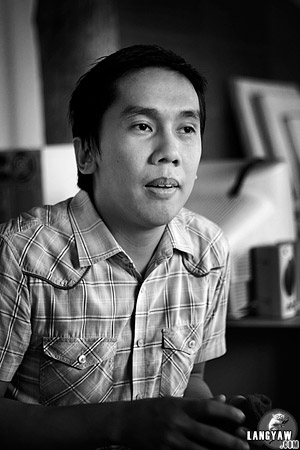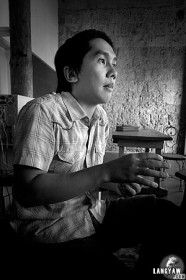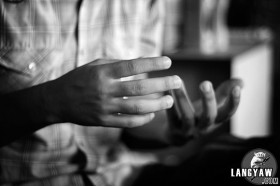

 Speak of Cebu and images of the Sto. Niño , the province’s patron, come to mind. And so does the valiant Lapu-Lapu, sweet mangoes, the famous lechon, guitars and beaches. But it is more than that. Cebu is a special and beautiful place. It is also my home.
Speak of Cebu and images of the Sto. Niño , the province’s patron, come to mind. And so does the valiant Lapu-Lapu, sweet mangoes, the famous lechon, guitars and beaches. But it is more than that. Cebu is a special and beautiful place. It is also my home.
 Starting with this post, I will be featuring travel and, especially local bloggers who embody a particular place, as well as other personalities from time to time. For this Cebu-Sugbo Kini series, I’m featuring Arnold Carl Sancover.
Starting with this post, I will be featuring travel and, especially local bloggers who embody a particular place, as well as other personalities from time to time. For this Cebu-Sugbo Kini series, I’m featuring Arnold Carl Sancover.
Part 1 | Part 2
ARNOLD CARL SANCOVER is a registered nurse, a true blue Cebuano and a staunch advocate of tangible heritage and its conservation. He’s also a frequent contributor to local newspapers writing about the province’s architectural treasures and is a volunteer at the Cathedral Museum of Cebu. His blog, The Heritage of Cebu was a finalist in the Philippine Blog Awards 09, Best Visayas Locale Blog category.

Ang Langyaw (AL): Arnold, can you tell me, how did you get into heritage advocacy?
Arnold Carl Sancover (ACS): I am into heritage and ever since I was a child that was already my interest. That was what I like. When I was about to enter college, originally, I would have enrolled in Anthropology but my parents would not allow since they were concerned that I might not have a future with it or end up just a teacher or what.
My parents wanted me to become a lawyer or a doctor and that’s why I took up Biology. After finishing the course, I took up Nursing as it was much more easier than Medicine and takes less time. After I graduated, my interest in heritage was still there. To express what I really want, I came up with a website on heritage.
 AL: Currently, how many blogs do you have?
AL: Currently, how many blogs do you have?
ACS: I currently have three blogs:
- The Heritage of Cebu (AL: this will be the focus of this interview)
- Travel Cebu, and
- Old Philippine Photos
I am focusing more and posts frequently at the the first one.
AL: How did you start with your The Heritage of Cebu blog?
ACS: This Cebu heritage blog first came to life at cebuheritage.wordpress.com. There were two instances that led to this one:
First I was walking along the downtown area of Cebu City (AL: this is the old quarter of Cebu where the country’s oldest street, Colon, is situated). That was December 30, 2005. I had with me a 3.2 megapixel digicam that I bought since I just passed the board exams.
While walking, I saw for the first time these heritage markers. Seeing these made my interest in heritage flare up more and so, I took pictures. I was already a member of this forum, Skyscraper City, and I want to post the images there so that I can make a topic about Cebu heritage.
Second, I was browsing this Ateneo (AL: Ateneo de Manila Univsersity) website, Panublion, and there was a topic there which really got me very interested: the Jesuit House of 1730. I got amazed since it was written that this heritage structure is hidden. When we speak of Parian, (AL: the old Chinese quarter of Cebu), what comes to mind is Casa Gorordo, a heritage house, now a museum of Cebu’s first Cebuano bishop. So there is still another house besides this one.
From Colon St., I went to the Parian area to look for this house without exactly knowing where it was located. In a sense, it was also an adventure for me. I came to an area where there was an old wall and saw these carved medallions, as exactly described in the website, I was ecstatic and decided to create a blog about Cebu heritage.
 AL: How was your blog? Heritage seems to be a minor topic.
AL: How was your blog? Heritage seems to be a minor topic.
ACS: Blogging about heritage is interesting and I came to find that there were lots of visitors to the site. I was enthusiastic and this all the more encouraged me to update the site frequently.
AL: Can you expound more about this traffic?
ACS: In WordPress, everytime I checked the stats, there were really around 100 unique visitors per day. In a few weeks, my visitors increased from zero to 4,000. I was amazed! I also found in WordPress the search key words people use that led them to my site: cebu churches, history of Sto. Niño, etc. Hala! Naa pud diay mga tao nga ingon ani diay. Mga hilig ug heritage (Oh, there are also people who are also interested with heritage). That there are also people who search google for these kind of topics. It was an eye opener for me.
These inspired me to keep on updating this blog.
AL: How do you look for topics in your blog? Information?
ACS: Basically, what are posted in my blog are the places that I have already visited. I’ve been to Boljoon and that’s why I have an entry of that place. Other info I get from books like Simbahan of Ricky Jose and Angels in Stone of Fr. Pedro Galende, and website like Panublion, among others.
AL: Have you met other heritage enthusiasts through your blog?
ACS: There were visitors to my blog who we can call the who’s who of Cebu heritage. One example is Trizer Mansueto (AL: historian, researcher and writer of several articles including an upcoming book on Cebu). A regular commenter on my blog and when we finally met, he introduced me to the Cathedral Museum of Cebu and the people who runs it.
These opened doors for my blog. I took advantage of the connections that I have made to further develop and make The Heritage of Cebu more credible. That it is not just pop history or I’m just making the posts up. Because of these blog and Trizer, I have made friends with the historians of the Sto. Niño Basilica. As I was already part of the cathedral museum, I get to travel with them in Boljoon, Dalaguete and interact with the people involved in the local heritage movement and thus, further enriching The Heritage of Cebu.
Next is Part 2 which will be Arnold Carl’s recommended non-church heritage sites in Cebu City.
Kudos to Arnold for initiating The Heritage of Cebu blog. I am currently here in Cebu and been traveling around. Langyaw has become my information source as well as heritage of Cebu.
Estan. I saw your photos displayed at the Cebu Cathedral Museum. I ordered a book which feature the treasures of the museum and the 150 churches of cebu. Very impressive initiative in promoting not only Cebu Heritage but Filipino Heritage in general.
Hello Estan, Thank you for introducing us to your friend Arnold. I’m amazed at all the historical information there is to learn about the Philippines, especially Cebu. I’m going to be more observant in the future in my meandering! Blogs such these are new to me, but have awakened in me a new curiosity and respect for Cebu’s rich past. I will continue to follow yours and others’ enthusiastic and fascinating insights into the country.
jherico, thanx bai. do have a wonderful trip around Cebu
queeniebee, thanx too. there are still so many hidden gems waiting to be explored in Cebu
Nice idea…look forward to discover other interesting blogs!
This is a great blog you have here! I have a travel blog myself which I hope it to be one of the top resources for those looking for experiences and advice on popular vacation destinations.
I’d like us to do a link exchange to help spread some traffic around to each other. This message is copied/pasted to save time, but I look at each site I submit a comment to.
Please let me know if this is possible.
Jason
ThatVACATIONfeeling.com
Nice feature! I love this theme! You managed to tweak it so much Michael ate his heart out.
I love this theme! You managed to tweak it so much Michael ate his heart out.
thanx kristine
Our very own Cebu is really rich in cultural history which I took for granted before.During my travels to Europe in the 90’s especially Spain and Portugal, the images I saw there especially the churches and the convents is just like a reflection of our baroque churches and historical buildings.I hope our fellow kababayans would be proud of our rich cultural heritage.Here in Tokyo where I’m based is totally different but also beautifully ambiguous after living here for 21 years…